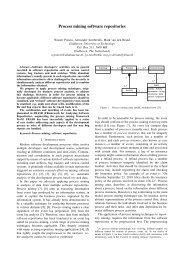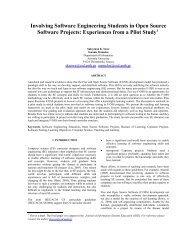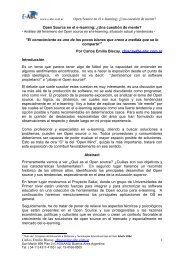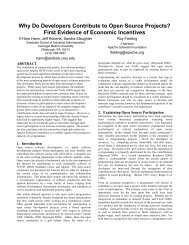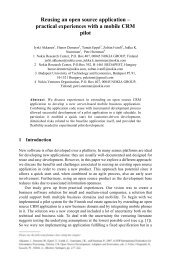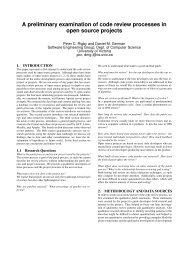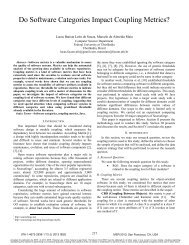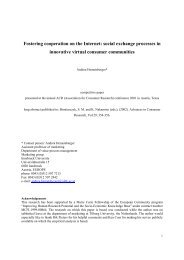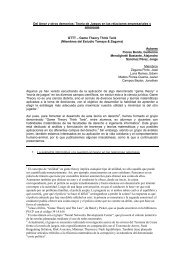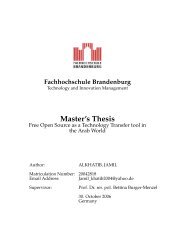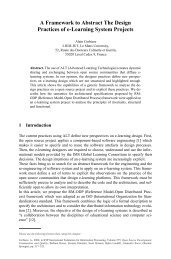Prioritizing Warning Categories by Analyzing Software ... - FLOSShub
Prioritizing Warning Categories by Analyzing Software ... - FLOSShub
Prioritizing Warning Categories by Analyzing Software ... - FLOSShub
Create successful ePaper yourself
Turn your PDF publications into a flip-book with our unique Google optimized e-Paper software.
<strong>Prioritizing</strong> <strong>Warning</strong> <strong>Categories</strong> <strong>by</strong> <strong>Analyzing</strong> <strong>Software</strong> History<br />
Sunghun Kim, Michael D. Ernst<br />
Computer Science & Artificial Intelligence Lab (CSAIL)<br />
Massachusetts Institute of Technology<br />
{hunkim, mernst}@csail.mit.edu<br />
Abstract<br />
Automatic bug finding tools tend to have high false<br />
positive rates: most warnings do not indicate real bugs.<br />
Usually bug finding tools prioritize each warning<br />
category. For example, the priority of “overflow” is 1<br />
and the priority of “jumbled incremental” is 3, but the<br />
tools’ prioritization is not very effective.<br />
In this paper, we prioritize warning categories <strong>by</strong><br />
analyzing the software change history. The underlying<br />
intuition is that if warnings from a category are<br />
resolved quickly <strong>by</strong> developers, the warnings in the<br />
category are important. Experiments with three bug<br />
finding tools (FindBugs, JLint, and PMD) and two<br />
open source projects (Columba and jEdit) indicate that<br />
different warning categories have very different<br />
lifetimes. Based on that observation, we propose a<br />
preliminary algorithm for warning category<br />
prioritizing.<br />
1. Introduction<br />
Bug finding tools such as FindBugs [6], JLint [1],<br />
and PMD [4] analyze source or binary code and warn<br />
about potential bugs. These tools tend to have a high<br />
rate of false positives: most warning instances do not<br />
indicate real bugs. These tools usually prioritize<br />
warning categories to put likely false positives at the<br />
bottom of the list, but these tools’ prioritization is not<br />
very effective [9].<br />
We use the software change history to prioritize<br />
warning categories. (Often warning instances from bug<br />
finding tools have categories such as overflow or NP<br />
always Null.) Suppose a software change would cause<br />
a bug finding tool to issue a warning instance from the<br />
overflow category. If a developer found the underlying<br />
problem and fixed it quickly, the warning category is<br />
probably important. (We do not assume the software<br />
developer is necessarily using the bug finding tool.)<br />
On the other hand, if a software change introduced a<br />
warning instance that was not removed for a long time,<br />
then warnings of that category may be neglectable,<br />
since the problem was not noticed or was not<br />
considered worth fixing.<br />
Using a version control system that stores a<br />
project’s change history, it is possible to find out when<br />
a file was changed or fixed [8]. We noticed that<br />
different warning categories have different lifetimes<br />
over software history. We list the most short-lived<br />
warning categories (which may be most important or<br />
useful) and the most long-lived warning categories.<br />
The warning category priorities assigned <strong>by</strong> bug<br />
finding tools do not match the priorities assigned based<br />
on warning category lifetimes. <strong>Prioritizing</strong> warning<br />
categories based on their lifetimes may help to make<br />
bug detection tools more useful.<br />
Our work aggregates properties of warning<br />
instances to prioritize warning categories. It does not<br />
give different priorities to two different instances from<br />
the same category. For example, warning instances<br />
from the overflow category have the same priority.<br />
This suggests that our technique will be most effective<br />
when the categories are relatively fine-grained and<br />
homogeneous (with respect to their importance and<br />
lifetime).<br />
2. Background and Related Work<br />
We introduce three bug finding tools briefly and<br />
discuss related work in this section.<br />
PMD finds syntactic error patterns from source<br />
code [4]. JLint analyzes Java <strong>by</strong>tecode and performs<br />
syntactic checking and data flow analysis to find<br />
potential bugs [1]. FindBugs also analyzes Java<br />
<strong>by</strong>tecode to find pre-defined error [6].<br />
Ruter et al. [10] compared bug finding tools for<br />
Java including PMD, JLint, and FindBugs. They<br />
analyze overlapping warning categories and category<br />
correlation. However, our approach prioritizes warning<br />
categories using change history while their work<br />
compares tools and finds similarities and differences<br />
among tools.<br />
Spacco et al. [11] observed FindBugs warning<br />
categories across software versions. They measure<br />
lifetimes of warning categories, warning number rates,<br />
and the degree of decay using warning numbers. This<br />
research is similar to ours in that they observe warning<br />
category trends over software history. However, they<br />
observe warning categories in very coarse grained<br />
software versions (in releases) while we observe<br />
categories in each version control system transaction.<br />
29th International Conference on <strong>Software</strong> Engineering Workshops(ICSEW'07)<br />
0-7695-2830-9/07 $20.00 © 2007
Kremenek and Engler [9] prioritize warning<br />
categories using frequency of defects. Similarly,<br />
Boogerd and Moonen [3] use execution likelihood<br />
analysis to prioritize warning instances. Our approach<br />
prioritizes warnings analyzing software history.<br />
3. Experiment Setup<br />
Table 1 gives information about our subject<br />
programs, JEdit 1 and Columba 2 . The Kenyon<br />
infrastructure is used to manage software history [2].<br />
Kenyon checks out the software transaction in the<br />
software change history. Then it compiles each<br />
transaction and creates a jar file or class files. Kenyon<br />
ignores transactions which cannot be compiled. For<br />
example, Kenyon only use 1,486 compilable<br />
transactions out of a total of 1,703 transactions for<br />
Columba. Using three bug finding tools (FindBugs,<br />
JLint, and PMD), Kenyon gets warning instances from<br />
each software transaction.<br />
Table 1. Analyzed Projects.<br />
Project <strong>Software</strong> type<br />
Period<br />
Columba Email Client 11/2002 ~<br />
06/2004<br />
09/2001 ~<br />
jEdit Editor<br />
11/2006<br />
# of compilable<br />
transaction<br />
# of<br />
transaction<br />
1,486 1,703<br />
1,200 1,509<br />
4. Experiment and Reprioritized <strong>Warning</strong><br />
<strong>Categories</strong><br />
We measure the lifetime of each warning category<br />
over software change history. Based on the lifetime,<br />
we prioritize each warning category.<br />
Whenever a warning instance appears in the<br />
software change history, that time and its category are<br />
marked. When the warning instance disappears, the<br />
time difference between the marked time and the<br />
current transaction time is the lifetime of the warning<br />
category. If a warning instance is never fixed, we give<br />
a penalty to the lifetime <strong>by</strong> adding 365 days. We then<br />
compute the average lifetime of instances in each<br />
category.<br />
The warning categories and their lifetimes of the<br />
two projects are shown in Figure 1 and Figure 2. Each<br />
bar in Figure 1 and Figure 2 presents a warning<br />
category. In Columba, some warning categories have a<br />
relatively short lifetime as marked in Figure 1. We<br />
assume warning instances in these categories are more<br />
serious than others. Similarly, some warning categories<br />
in Columba have relatively long lifetimes, and<br />
warnings in these categories are less likely to be real<br />
bugs.<br />
Lifetime (days)<br />
500<br />
450<br />
400<br />
350<br />
300<br />
250<br />
200<br />
150<br />
100<br />
short-lived<br />
50<br />
0<br />
<strong>Warning</strong>s categories ordered <strong>by</strong> lifetime<br />
Figure 1. <strong>Warning</strong> category lifetimes of Columba.<br />
long-lived<br />
JEdit warning category lifetimes in Figure 2 have<br />
similar properties: some have very short lifetimes<br />
while some have long lifetimes.<br />
Lifetime (days)<br />
2000<br />
1800<br />
1600<br />
1400<br />
1200<br />
1000<br />
800<br />
600<br />
400 short-lived<br />
200<br />
0<br />
<strong>Warning</strong>s categories ordered <strong>by</strong> lifetime<br />
Figure 2. <strong>Warning</strong> category lifetimes of jEdit.<br />
long-lived<br />
After computing lifetimes for all warning categories,<br />
we order categories <strong>by</strong> their lifetime. The top 10 shortlived<br />
and long-lived warning categories with detailed<br />
information are listed in Table 2 and Table 3. The<br />
ranks are given based on the lifetimes. The priorities<br />
shown in Table 2 and Table 3 are given <strong>by</strong> the<br />
corresponding bug finding tool. For example, in<br />
Columba, the 7 th ranked warning category is SA<br />
FIELD SELF ASSIGNMENT (the priority given <strong>by</strong><br />
FindBugs is 1) occurs 8 times and is fixed within 9<br />
days on average. The high priority such as 1 given <strong>by</strong><br />
bug finding tools does not necessarily mean that the<br />
warning category is a short-lived one. For example, the<br />
priority of Weak cmp (rank 108) of JLint is 1, but its<br />
lifetime is very long, 291 days. Note that FindBugs<br />
sometimes gives different priorities to the same<br />
category (see the rank 6 and 7 in Columba).<br />
Are warning category lifetimes between two<br />
projects correlated? We measured the Pearson’s<br />
correlation coefficient between the common warning<br />
category lifetimes shown in the two projects. The<br />
coefficient, r, is 0.218 which indicates the category<br />
lifetimes between the two projects have no correlation.<br />
1 The jEdit project: http://www.jedit.org/<br />
2 The Columba project: http://www.columbamail.org/<br />
29th International Conference on <strong>Software</strong> Engineering Workshops(ICSEW'07)<br />
0-7695-2830-9/07 $20.00 © 2007
Table 2. Columba top 10 short-lived and long-lived warning categories ordered <strong>by</strong> their lifetime.<br />
Rank<br />
Tool<br />
Tool<br />
Priority<br />
(1 is high)<br />
Category Group<br />
Category<br />
Occurrence<br />
Lifetime (days)<br />
Average Standard<br />
deviation<br />
1 FindBugs 1 CORRECTNESS NP NULL PARAM DEREF<br />
NONVIRTUAL<br />
1 0.16 0<br />
2 JLint 1 wait_nosync Wait nosync 1 1.0 0<br />
3 PMD 3 Basic Rules Unconditional If Statement 1 1.1 0<br />
4 FindBugs 1 BAD PRACTICE DE MIGHT IGNORE 1 2.8 0<br />
5 FindBugs 2 STYLE SF SWITCH FALLTHROUGH 2 6.2 0.16<br />
6 FindBugs 2 CORRECTNESS SA FIELD SELF ASSIGNMENT 2 8.9 0<br />
7 FindBugs 1 CORRECTNESS SA FIELD SELF ASSIGNMENT 8 8.9 0<br />
8 FindBugs 2 STYLE SA LOCAL SELF ASSIGNMENT 2 8.9 0<br />
9 FindBugs 2 STYLE IM BAD CHECK FOR ODD 2 13.4 9.44<br />
10 JLint 1 zero_result Zero result 2 17.1 0<br />
108 JLint 1 weak_cmp Weak cmp 98 291.1 27.29<br />
109 FindBugs 1 MALICIOUS CODE MS MUTABLE ARRAY 3 292.1 23.12<br />
110 FindBugs 1 CORRECTNESS NP NONNULL RETURN WARNING 2 295.9 190.21<br />
111 FindBugs 2 STYLE BC UNCONFIRMED CAST 94 308.5 29.66<br />
112 JLint 1 Not overridden Hashcode not overridden 12 324.1 19.43<br />
113 PMF 3 Basic Rules Override Both Equals And Hashcode 10 337.4 2.07<br />
114 FindBugs 2 CORRECTNESS NP GUARANTEED DEREF 3 345.1 126.86<br />
115 FindBugs 2 BAD_PRACTICE OS OPEN STREAM 9 374.7 10.57<br />
116 FindBugs 2 BAD_PRACTICE SE BAD FIELD STORE 3 376.7 81.81<br />
118 FindBugs 1 CORRECTNESS EC UNRELATED TYPES 2 431.0 113.73<br />
Table 3. jEdit top 10 short-lived and long-lived warning categories ordered <strong>by</strong> their lifetime.<br />
Rank Tool<br />
Tool<br />
Lifetime (days)<br />
Occurrence<br />
Average Standard<br />
(1 is high)<br />
deviation<br />
Priority Category Group<br />
Category<br />
1 FindBugs 1 CORRECTNESS NP ALWAYS NULL 1 0.01 0<br />
2 FindBugs 1 CORRECTNESS NP NULL PARAM DEREF<br />
NONVIRTUAL<br />
1 0.02 0<br />
3 JLint 1 Bounds Bad index 1 0.028 0<br />
4 FindBugs 1 BAD_PRACTICE DE MIGHT IGNORE 1 1.2 0<br />
5 JLint 1 Overflow Overflow 1 2 0<br />
6 JLint 1 Domain Shift count 1 2 0<br />
7 FindBugs 1 CORRECTNESS ICAST BAD SHIFT AMOUNT 1 2 0<br />
8 JLint 1 Zero result Zero result 1 24.1 0<br />
9 FindBugs 2 CORRECTNESS NP UNWRITTEN FIELD 5 28.7 44.90<br />
10 FindBugs 2 STYLE SA LOCAL SELF ASSIGNMENT 1 47.1 0<br />
115 PMD 3 Basic Rules Jumbled Incrementer 3 1733 182.59<br />
116 FindBugs 2 MT CORRECTNESS SC START IN CTOR 2 1735 0<br />
117 FindBugs 2 BAD PRACTICE DM EXIT 3 1787 60.41<br />
118 FindBugs 2 BAD PRACTICE ES COMPARING STRINGS WITH<br />
EQ<br />
2 1892 0<br />
119 FindBugs 2 MT CORRECTNESS WA NOT IN LOOP 2 1892 0<br />
120 FindBugs 2 BAD PRACTICE RR NOT CHECKED 1 1892 0<br />
121 FindBugs 2 MALICIOUS CODE MS OOI PKGPROTECT 2 1892 0<br />
122 FindBugs 2 BAD PRACTICE SR NOT CHECKED 1 1892 0<br />
123 FindBugs 1 BAD PRACTICE SR NOT CHECKED 1 1892 0<br />
124 FindBugs 2 MALICIOUS CODE EI EXPOSE STATIC REP2 1 1892 0<br />
29th International Conference on <strong>Software</strong> Engineering Workshops(ICSEW'07)<br />
0-7695-2830-9/07 $20.00 © 2007
There are ambiguities in this experiment. For<br />
example, suppose foo.c changes over transaction 1, 2,<br />
3, and 4 as shown in Figure 3. Suppose a warning<br />
instance in the (x) category exists at transaction 1 and<br />
another warning instance in the (x) category was added<br />
at transaction 2. At transaction 3, a warning instance in<br />
the (x) category was removed and at transaction 4, the<br />
remaining one was removed.<br />
(x) (x)(x) (x)<br />
Transaction 1 Transaction 2<br />
Transaction 3 Transaction 4<br />
Figure 3. A warning instance addition and removal example<br />
of foo.c.<br />
It is not clear whether between transaction 1 and 2,<br />
two warning instances are added (and the warning<br />
instance in transaction 1 is deleted) or only one<br />
warning instance is added (and the warning instance in<br />
transaction 1 remains). Similarly, it is not clear which<br />
warning instance is removed between transaction 2 and<br />
3. It is possible that all warning instances disappear<br />
and a new warning instance (in the same category)<br />
appears between transaction 2 and 3. To simplify the<br />
experiments, we measure a lifetime as the period of the<br />
first appearance of warning instances from a warning<br />
category until there is no warning instance from the<br />
same category per file. In this example, the lifetime of<br />
the warning category is the time difference between<br />
transaction 1 to transaction 4.<br />
5. Discussion<br />
It is hard to trace line changes and it is also hard to<br />
trace warning instance changes between transactions.<br />
The annotation graph could solve this problem<br />
partially <strong>by</strong> mapping each line between two<br />
transactions [12]. When a file name changes between<br />
two transactions, we will lose warning category change<br />
trends or lifetime information, it is necessary to use<br />
origin analysis techniques [5, 7]. Even though it is<br />
possible that warning instance lifetimes in a category<br />
vary, we use the average to measure a category<br />
lifetime. Our prioritization approach does not remove<br />
false positives of warning instances. However, it puts<br />
the bugs (true positives) at the top of the warning list<br />
and false positives at the bottom to make bug finding<br />
tools more useful.<br />
Our analysis does not utilize developer assessments<br />
of the severity of each problem: our technique assumes<br />
that the more critical problems are fixed quickly, but it<br />
is conceivable that some important problems (say that<br />
cause incorrect behavior) are not corrected for a long<br />
time.<br />
6. Conclusions and Future Work<br />
We ran three bug finding tools on each<br />
development transaction of two open source projects,<br />
Columba and JEdit. We computed the lifetime of each<br />
warning category, and found that some warning<br />
categories have a short lifetime, while others have a<br />
long lifetime. We propose prioritization of each<br />
warning category based on its observed lifetime. This<br />
is a generic prioritization approach applicable to any<br />
bug finding tools.<br />
For future work we need to evaluate the prioritized<br />
warning categories through user study or validation<br />
using the change history.<br />
7. References<br />
[1] C. Artho, "JLint - Find Bugs in Java Programs," 2006,<br />
http://jlint.sourceforge.net/.<br />
[2] J. Bevan, E. J. Whitehead, Jr., S. Kim, and M. Godfrey, "Facilitating<br />
<strong>Software</strong> Evolution with Kenyon," Proc. of the 2005 European<br />
<strong>Software</strong> Engineering Conference and 2005 Foundations of <strong>Software</strong><br />
Engineering (ESEC/FSE 2005), Lisbon, Portugal, pp. 177-186, 2005.<br />
[3] C. Boogerd and L. Moonen, "<strong>Prioritizing</strong> <strong>Software</strong> Inspection<br />
Results using Static Profiling," Proc. of the Sixth IEEE International<br />
Workshop on Source Code Analysis and Manipulation (SCAM'06),<br />
pp. 149-160, 2006.<br />
[4] T. Copeland, PMD Applied: Centennial Books, 2005.<br />
[5] M. W. Godfrey and L. Zou, "Using Origin Analysis to Detect<br />
Merging and Splitting of Source Code Entities," IEEE Trans. on<br />
<strong>Software</strong> Engineering, vol. 31, no. 2, pp. 166-181, 2005.<br />
[6] D. Hovemeyer and W. Pugh, "Finding Bugs is Easy," Proc. of the<br />
19th Object Oriented Programming Systems Languages and<br />
Applications (OOPSLA '04), Vancouver, British Columbia, Canada,<br />
pp. 92-106, 2004.<br />
[7] S. Kim, K. Pan, and E. J. Whitehead, Jr., "When Functions Change<br />
Their Names: Automatic Detection of Origin Relationships," Proc.<br />
of 12th Working Conference on Reverse Engineering (WCRE 2005),<br />
Pennsylvania, USA, pp. 143-152, 2005.<br />
[8] S. Kim, T. Zimmermann, K. Pan, and E. J. Whitehead, Jr.,<br />
"Automatic Identification of Bug Introducing Changes," Proc. of<br />
21st IEEE/ACM International Conference on Automated <strong>Software</strong><br />
Engineering (ASE 2006), Tokyo, Japan, 2006.<br />
[9] T. Kremenek and D. R. Engler, "Z-ranking: Using statistical analysis<br />
to counter the impact of static analysis approximations," Proc. of the<br />
10th International Symposium on Static Analysis (SAS 2003), San<br />
Diego, CA, USA, pp. 295-315, 2003.<br />
[10] N. Rutar, C. B. Almazan, and J. S. Foster, "A Comparison of Bug<br />
Finding Tools for Java," Proc. of 15th IEEE International<br />
Symposium on <strong>Software</strong> Reliability Engineering (ISSRE'04), Saint-<br />
Malo, Bretagne, France, pp. 245-256, 2004.<br />
[11] J. Spacco, D. Hovemeyer, and W. Pugh, "Tracking Defect <strong>Warning</strong>s<br />
Across Versions," Proc. of Int'l Workshop on Mining <strong>Software</strong><br />
Repositories (MSR 2006), Shanghai, China, pp. 133-136, 2006.<br />
[12] T. Zimmermann, S. Kim, A. Zeller, and E. J. Whitehead, Jr.,<br />
"Mining Version Archives for Co-changed Lines," Proc. of Int'l<br />
Workshop on Mining <strong>Software</strong> Repositories (MSR 2006), Shanghai,<br />
China, pp. 72-75, 2006.<br />
29th International Conference on <strong>Software</strong> Engineering Workshops(ICSEW'07)<br />
0-7695-2830-9/07 $20.00 © 2007



